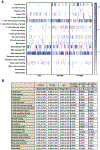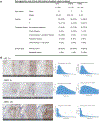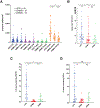The Immunosuppressive Niche of Soft-Tissue Sarcomas is Sustained by Tumor-Associated Macrophages and Characterized by Intratumoral Tertiary Lymphoid Structures
- PMID: 32332015
- PMCID: PMC8772618
- DOI: 10.1158/1078-0432.CCR-19-3416
The Immunosuppressive Niche of Soft-Tissue Sarcomas is Sustained by Tumor-Associated Macrophages and Characterized by Intratumoral Tertiary Lymphoid Structures
Abstract
Purpose: Clinical trials with immune checkpoint inhibition in sarcomas have demonstrated minimal response. Here, we interrogated the tumor microenvironment (TME) of two contrasting soft-tissue sarcomas (STS), rhabdomyosarcomas and undifferentiated pleomorphic sarcomas (UPS), with differing genetic underpinnings and responses to immune checkpoint inhibition to understand the mechanisms that lead to response.
Experimental design: Utilizing fresh and formalin-fixed, paraffin-embedded tissue from patients diagnosed with UPS and rhabdomyosarcomas, we dissected the TME by using IHC, flow cytometry, and comparative transcriptomic studies.
Results: Our results demonstrated both STS subtypes to be dominated by tumor-associated macrophages and infiltrated with immune cells that localized near the tumor vasculature. Both subtypes had similar T-cell densities, however, their in situ distribution diverged. UPS specimens demonstrated diffuse intratumoral infiltration of T cells, while rhabdomyosarcomas samples revealed intratumoral T cells that clustered with B cells near perivascular beds, forming tertiary lymphoid structures (TLS). T cells in UPS specimens were comprised of abundant CD8+ T cells exhibiting high PD-1 expression, which might represent the tumor reactive repertoire. In rhabdomyosarcomas, T cells were limited to TLS, but expressed immune checkpoints and immunomodulatory molecules which, if appropriately targeted, could help unleash T cells into the rest of the tumor tissue.
Conclusions: Our work in STS revealed an immunosuppressive TME dominated by myeloid cells, which may be overcome with activation of T cells that traffic into the tumor. In rhabdomyosarcomas, targeting T cells found within TLS may be key to achieve antitumor response.
©2020 American Association for Cancer Research.
Conflict of interest statement
Disclosure of Potential Conflicts of Interest
G. Cojocaru is an employee/paid consultant for Compugen LTD. C.F. Meyer is an employee/paid consultant for Bayer, and reports receiving speakers bureau honoraria from Novartis. D.J. McConkey is an employee/paid consultant for Janssen, Rainier, and H3 Biomedicine, and reports receiving commercial research grants from Astra-Zeneca and Rainier. No potential conflicts of interest were disclosed by the other authors.
Figures







References
-
- Ries LAG, Smith MA, Gurney JG, Linet M, Tamra T, Young JL, et al. Cancer incidence and survival among children and adolescents: United States SEER Program 1975–1995, NCI. Available from: https://seer.cancer.gov/archive/publications/childhood/childhood-monogra....
-
- Ng VY, Scharschmidt TJ, Mayerson JL, Fisher JL. Incidence and survival in sarcoma in the United States: a focus on musculoskeletal lesions. Anticancer Res 2013;33:2597–604. - PubMed
Publication types
MeSH terms
Substances
Grants and funding
LinkOut - more resources
Full Text Sources
Research Materials

